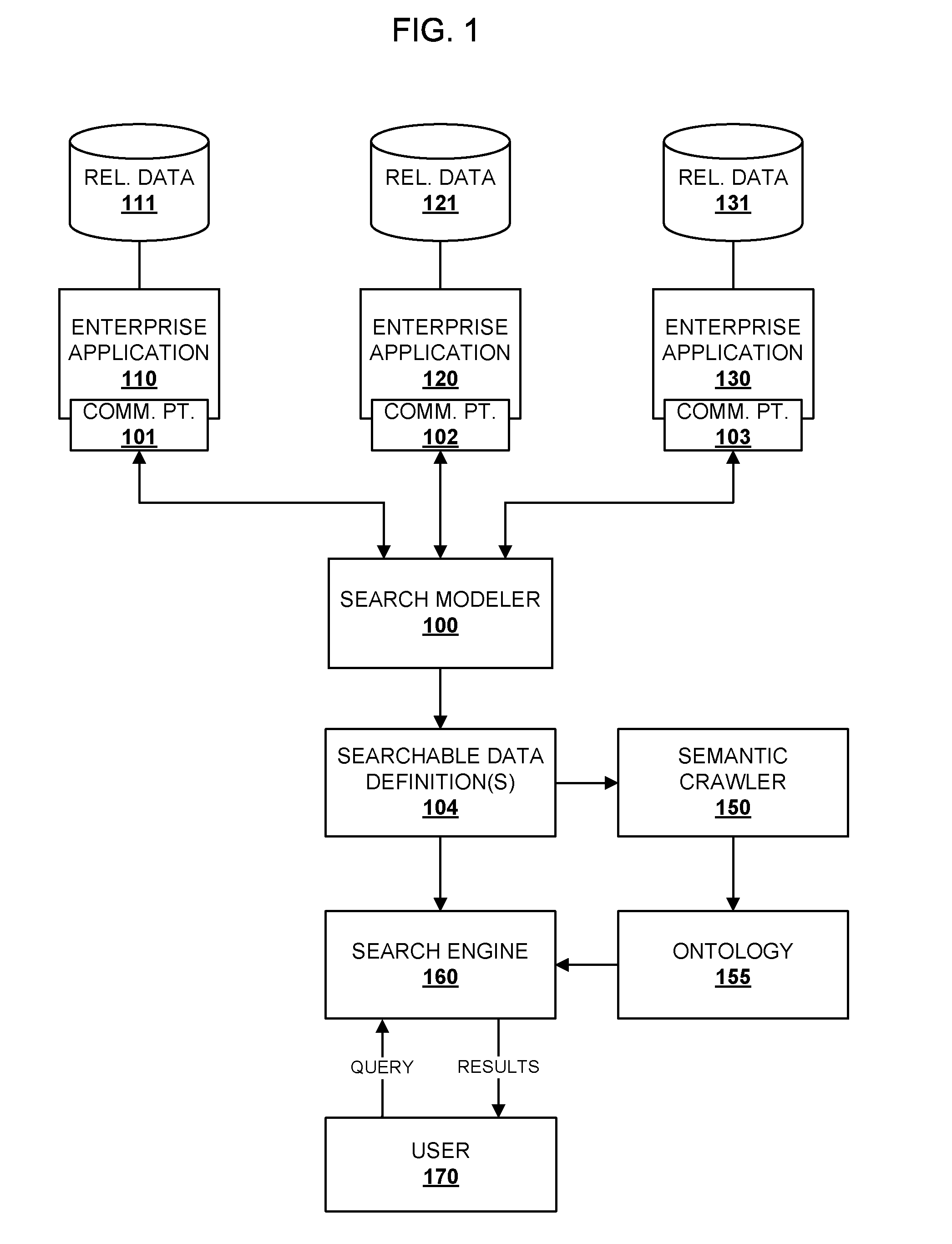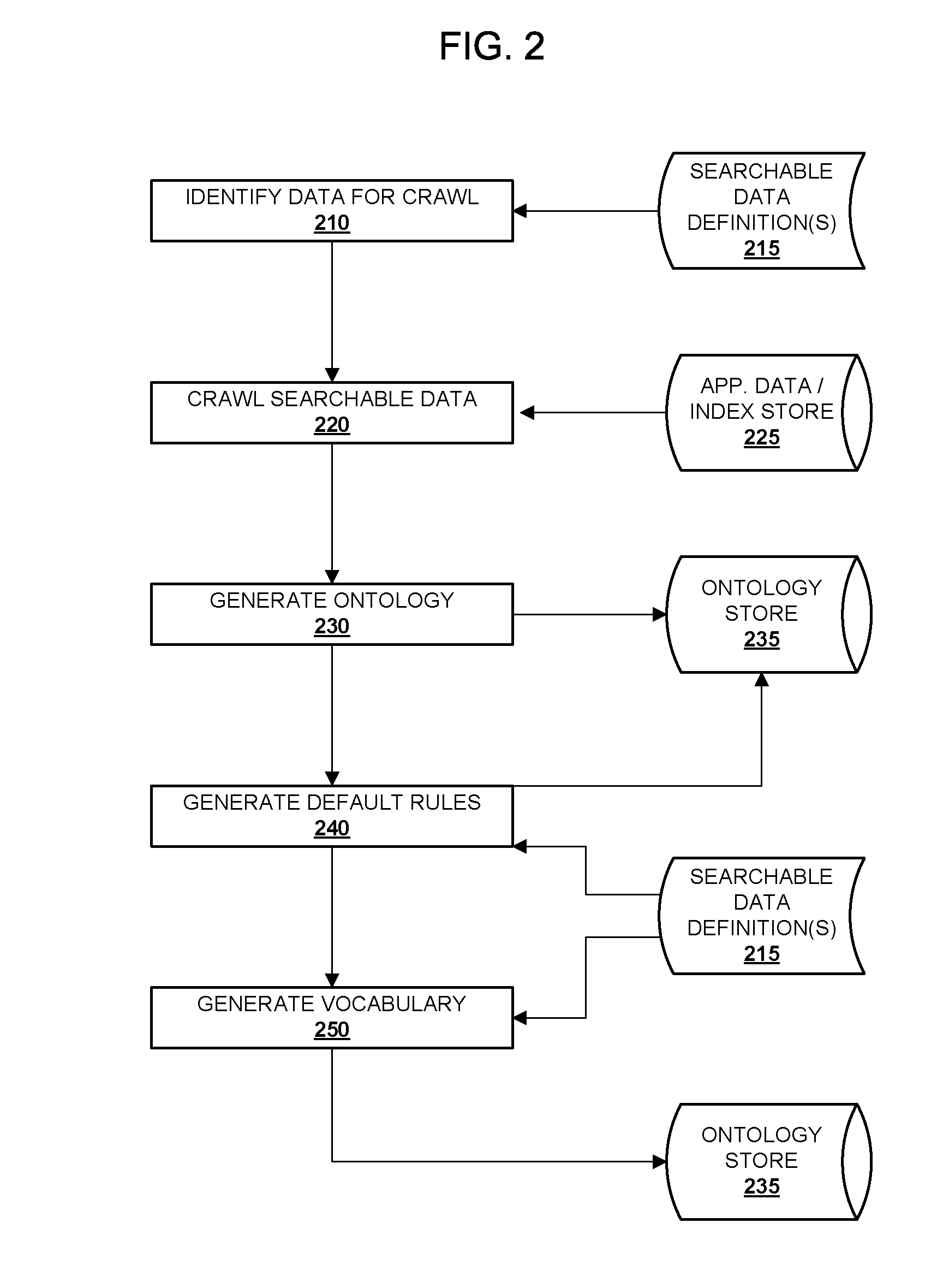System and Method for Semantic Search in an Enterprise Application
a semantic search and enterprise application technology, applied in the field of enterprise systems, can solve the problems of not being able to easily find text, not being able to present to end users, not being able to find text, etc., and unable to achieve semantic relationships within data,
- Summary
- Abstract
- Description
- Claims
- Application Information
AI Technical Summary
Benefits of technology
Problems solved by technology
Method used
Image
Examples
example 1
[0064]
User Query:STANDARD purchase ordersTagged Output:STANDARD / JJ purchase / NN orders / NNSTokens Found:STANDARD, purchase, ordersVocabulary Tokens:purchase, ordersInstances Found:STANDARDSPARQL Query:PREFIX ref: SELECT *{?x rdf:PO_HEADER_ID ?purchase. ?x?prop6 ‘STANDARD’. }
In Example 1, the query requests all purchase orders of type “STANDARD.” The example shows how the entered query is analyzed for ontology entities and translated to a corresponding semantic search.
[0065]As previously described, a search query may be tagged to identify terms or types of terms in the query. A search system according to an embodiment of the invention may receive natural language or other text queries. A query may be processed by a part-of-speech tagger to produce the tagged output described in the examples. A specific example of a tagger suitable for use with embodiments of the invention is the Natural Language Parts of Speech Tagger from Stanford University, available at http: / / nlp.stanford.edu / softw...
example 2
[0068]
User Query:purchase orders vendor type lookup codeinternal currency code EURTagged Output:purchase / NN orders / NNS vendor / NNtype / NN lookup / NN code / NN Internal / NNPcurrency / NN code / NN EUR / NNPTokens Found:purchase, orders, vendor, type,lookup, code, Internal, currency, code, EURVocabulary Tokens:purchase, orders, vendor, type, lookup,code, currency, codeInstances Found:Internal, EURSPARQL Query:PREFIX ref: SELECT *{?x rdf:PO_HEADER_ID ?purchase. ?x?prop59 ‘Internal’. ?x ?prop60‘EUR’. ?x rdf:VENDOR_ID ?vendor.}
The query in Example 2 requests all purchase orders having a vendor type of “INTERNAL” and issued in Euros (EUR). As illustrated by Example 2, a semantic query may include elements of plain language queries, such as “currency code EUR,” as well as query structures specific to the application or the enterprise system, such as “lookup code internal.” Other query structures may be included. As previously described, the query may be analyzed to isolate terms suitable for a semanti...
example 3
[0069]
User Query:vendor having invoice currency code EURTagged Output:vendor / NN having / VBG / invoice / JJ currency / NN code / NN EUR / NNPTokens Found:vendor, invoice, currency, code, EURVocabulary Tokens:vendor, invoice, currency, codeInstances Found:EURSPARQL Query:PREFIX ref: SELECT *{?x rdf:INVOICE_NUM ?invoice. ?x?prop12 ‘EUR’. ?x rdf:VENDOR_ID ?vendor.}
This example shows a query for separate entities that have a semantic relationship, specifically, a query requesting vendors for whom there is at least one invoice in Euros. The “vendor” and “payable invoices” logical entities are involved in processing the query, but the association of a vendor with a payable invoice is through the associated purchase order, which is not present in the query. In the example system according to an embodiment of the invention, the semantic search system is “aware” of the intermediate implicit entries since they are described by an ontology associated with the application.
[0070]As previously described, t...
PUM
 Login to View More
Login to View More Abstract
Description
Claims
Application Information
 Login to View More
Login to View More - R&D
- Intellectual Property
- Life Sciences
- Materials
- Tech Scout
- Unparalleled Data Quality
- Higher Quality Content
- 60% Fewer Hallucinations
Browse by: Latest US Patents, China's latest patents, Technical Efficacy Thesaurus, Application Domain, Technology Topic, Popular Technical Reports.
© 2025 PatSnap. All rights reserved.Legal|Privacy policy|Modern Slavery Act Transparency Statement|Sitemap|About US| Contact US: help@patsnap.com



